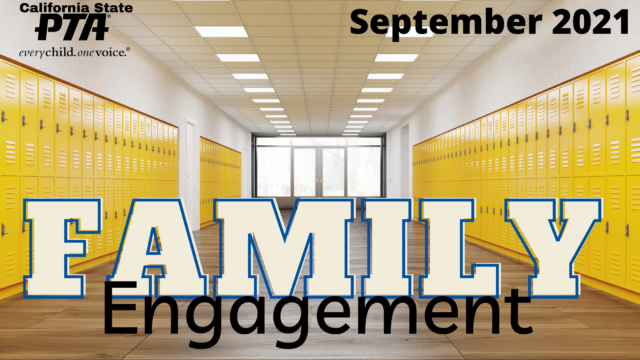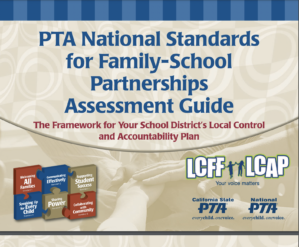by Kathleen Fay, California State PTA Family Engagement Commission Consultant
At this time of year, California school districts can demonstrate their commitment to family engagement in their Local Control and Accountability Plans (LCAP). National PTA Standards for Family-School Partnerships include two principles that have particular relevance during the spring season of the LCAP when districts are making their final decisions about their budgets and priorities.
Do you know if these family engagement standards, from National PTA Standards for Family-School Partnerships Assessment Guide, are being met as part of your district’s LCAP process?
- Principal 4 = Families are empowered to be advocates for their own and other children, to ensure that students are treated fairly and have access to learning opportunities that will support their success.
- Principle 3 – Families and school staff are equal partners in decisions that affect children and families and together inform, influence, and create policies, practices, and programs.
As part of their local accountability work, school districts have to report on Priority #3: Parent Involvement, which requires school districts to seek parent input in making decisions for their schools and to promote family participation in education programs for all students. But the way a district chooses to seek that input varies widely depending on how district leaders choose to handle it. For example, some districts encourage families to come to open public input sessions held at each school site, while others (sadly) do little more than send parents a survey to rank their satisfaction with a shortlist of pre-selected issues.
One of the most impactful ways families and caregivers can offer input into the LCAP process is to participate in their school district’s Parent Advisory Committee, which provides advice to the governing board and superintendent regarding the development of the LCAP. If school district enrollment includes at least 15 percent English learners and at least 50 pupils who are English learners, there should also be an English learner parent advisory committee established for the district. You can ask your school principal how to sign up to participate.
What issues should you consider when offering your input? What’s important to your family that the school should be doing better? PTA and Ed100 have created an LCAP Checklist to help you think through what’s important. It gives you the background you need and questions to ask. PTA leaders can share it to get people engaged and use it as a tool to organize a public input session for your unit. Here’s the link: LCAP CHECKLIST
Other ways PTA leaders can support parent involvement in the LCAP process:
- Find and download your district’s LCAP, then share it for easy access by parents.
- Invite your school/district administrator to be a guest speaker at a PTA meeting or special forum held to explain the contents of your LCAP and suggest avenues for parent input.
- Offer a presentation to review and then openly discuss what the California School Dashboard reveals about your school’s strengths, challenges, and areas in need of improvement.
- Organize at least one open input session for your unit so that your school community’s recommendations can be collected, documented, and submitted to the LCAP Advisory Committee for further consideration.
- Create a better climate for family-school partnerships by working through PTA’s Standards for Family-School Partnerships Assessment Guide. Summary and full guide available in English and Spanish at: https://capta.org/resource/family-school-partnerships/.
- Work with your district to create a family-friendly summary of your LCAP that uses graphics and plain language to clarify who is being helped and how (student populations targeted and resources devoted to them).
The LCAP is a key tool for making certain that schools and districts are held accountable to the community for the education of its children. Make sure that your PTA supports an engaged parent community to guide policy and make decisions that improve your school. Remember, it begins with Local Control!
Brief Overview: Local Control and Accountability Plan (LCAP)
The LCAP uses a state-provided template as a tool to help districts set goals, plan actions, and leverage resources to meet those goals to improve student outcomes. Essentially, the LCAP is the document that spells out how the district plans to spend its limited resources to achieve what’s important.
The LCAP is adopted to be effective for three years and is updated each year as part of your district’s annual budget process (due each June). LCAPs must explicitly address the needs of consistently low-performing student groups as well as low-performing schools within the district. Meeting the needs of English language learners, students in poverty, and foster youth have a particularly high priority, established by state requirements. As a parent, you have a right to contribute your input in this process.
Want to know what’s in your LCAP? School districts are required to post their LCAPs online to publicly disclose how they spend education funds. But while some districts post a clear link to it on their homepage, others make it hard to find, so you may have to do some searching.
Make your voice heard when your school district considers key decisions about its future through the development of its LCAP! For additional information about the LCAP process and ways for parents to get involved, go to https://capta.org/focus-areas/lcfflcap/





